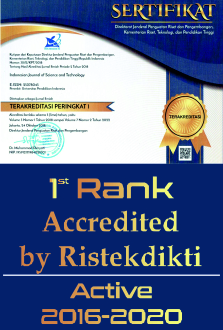Amorphous Iron Phosphate: Inorganic Sol-Gel Synthesis-Sodium and Potassium Insertion
Abstract
Amorphous iron phosphate, FePO4.2H2O, was synthesized at ambient temperature using an inorganic sol-gel method coupled with a microwave route. The experimental conditions for the gelling of the Fe (III)-H3PO4 system are defined. Potentiometric Time Titration (PTT) and Potentiometric Mass Titration (PMT) methods were used to investigate the acid-base surface chemistry of obtained phosphate. Variations of surface charge with the contact time, Q = f(t), are examined for time contact ranged from 0 to 72 hours. The concentrations suspensions used for this purpose were 0.75, 1.25, and 2.5 g/L. The point of zero charges (PZC) and isoelectric point (IEP) were defined using the derivative method examining the variations , at lower contact time. A value of 5.4 was obtained for both PZC and IEP. Q in the function of the t method is performed for synthesized FePO4. 2H2O in NaCl and KCl electrolytes. The optimal surface charge of 40 C corresponding to insertion of 4.2x10-4 M of Na+ or K+, is achieved in explored conditions. The results suggest that the synthesized iron phosphate is amorphous.
Keywords
Full Text:
PDFReferences
Abram, U., and Alberto, R. (2006). Technetium and rhenium: coordination chemistry and nuclear medical applications. Journal of the Brazilian Chemical Society, 17, 1486-1500.
Ai, M., and Ohdan, K. (1999). Effects of the method of preparing iron orthophosphate catalyst on the structure and the catalytic activity. Applied Catalysis A: General, 180(1-2), 47-52.
Akkermans, R. L., Spenley, N. A., and Robertson, S. H. (2013). Monte Carlo methods in materials studio. Molecular Simulation, 39(14-15), 1153-1164.
Berzina-Cimdina, L., and Borodajenko, N. (2012). Research of calcium phosphates using Fourier transform infrared spectroscopy. Infrared Spectroscopy-Materials Science, Engineering and Technology, 12(7), 251-263.
Cappuyns, V., and Swennen, R. (2008). The use of leaching tests to study the potential mobilization of heavy metals from soils and sediments: a comparison. Water, Air, and Soil Pollution, 191(1), 95-111.
De Tommaso, G., and Iuliano, M. (2012). Acid–Base Properties of the Surface of Hydrous Ferric Phosphate in Aqueous Solutions. Journal of Chemical and Engineering Data, 57(1), 52-59.
Destainville, A., Champion, E., Bernache-Assollant, D., and Laborde, E. (2003). Synthesis, characterization and thermal behavior of apatitic tricalcium phosphate. Materials Chemistry and Physics, 80(1), 269-277.
Ellouzi, K., Elyahyaoui, A., and Bouhlassa, S. (2016). Calcium and strontium hydroxyapatites: Microwave accelerated inorganic sol-gel synthesis, and potentiometric determining of the Point of Zero Charge (PZC) and isoelectric point (IEP). The Pharma Letter, 8, 237-245.
Elyahyaoui, A., Ellouzi, K., Al Zabadi, H., Razzouki, B., Bouhlassa, S., Azzaoui, K Mejdoubi, E.M., Hamed, O., Jodeh, S. and Lamhamdi, A., (2017). Adsorption of chromium (VI) on calcium phosphate: mechanisms and stability constants of surface complexes. Applied Sciences, 7(3), 222.
Errich, A., Azzaoui, K., Mejdoubi, E., Hammouti, B., Abidi, N., Akartasse, N., Benidire, L., Hajjaji, S.E., Sabbahi, R. and Lamhamdi, A. (2021). Toxic heavy metals removal using a hydroxyapatite and hydroxyethyl cellulose modified with a new Gum Arabic. Indonesian Journal of Science and Technology, 6(1), 41-64.
Gabaudan, V., Monconduit, L., Stievano, L., and Berthelot, R. (2019). Snapshot on negative electrode materials for potassium-ion batteries. Frontiers in Energy Research, 7, 46.
Gongyan, W., Li, L., and Fang, H. (2018). Dehydration of FePO 4· 2H 2 O for the synthesis of LiFePO 4/C: effect of dehydration temperature. International Journal of Electrochemical Science, 13, 2498-508.
Han, J. K., Song, H. Y., Saito, F., and Lee, B. T. (2006). Synthesis of high purity nano-sized hydroxyapatite powder by microwave-hydrothermal method. Materials Chemistry and Physics, 99(2-3), 235-239.
Ikram, U., Khalida, A., Kausar, I., and Arshia, S.F. (1998). Effect of phosphate enrichement on the metal adsorption Properties of hydrous iron oxide. Journal of the Chemical Society of Pakistan, 20(2), 99-109.
Jarlbring, M., Gunneriusson, L., and Forsling, W. (2005). Protolytic Surface Reactions of a Fluorapatite− Maghemite Mixture in Aqueous Suspension. Langmuir, 21(17), 7717-7721.
Jarlbring, Sandstrtim, D.E., Antzutkin, O.N., Holmgren, A., and Forsling, W. (2006). The surface properties of aqueous fluorapatite and maghemite with reference to the dephosphorization of magnetite. Proceedings of the International Seminar on Mineral Processing Technology, Chennai, India, 270 - 277.
Kandori, K., Kuwae, T., and Ishikawa, T. (2006). Control on size and adsorptive properties of spherical ferric phosphate particles. Journal of Colloid and Interface Science, 300(1), 225-231.
Kang, B., and Ceder, G. (2009). Battery materials for ultrafast charging and discharging. Nature, 458(7235), 190-193.
Lee, A. Y. W., Lim, S. F., Chua, S. N., Sanaullah, K., Baini, R., and Abdullah, M. O. (2017). Adsorption equilibrium for heavy metal divalent ions (Cu2+, Zn2+, and Cd2+) into zirconium-based ferromagnetic sorbent. Advances in Materials Science and Engineering, 2017, 1-13.
Lee, J. H., Kim, H. H., Kim, G. S., Zang, D. S., Choi, Y. M., Kim, H., Yi, D.K., Sigmund, W.M. and Paik, U. (2010). Evaluation of surface acid and base properties of LiFePO4 in aqueous medium with pH and its electrochemical properties. The Journal of Physical Chemistry C, 114(10), 4466-4472.
Lenoble, V., Laclautre, C., Deluchat, V., Serpaud, B., and Bollinger, J. C. (2005). Arsenic removal by adsorption on iron (III) phosphate. Journal of Hazardous Materials, 123(1-3), 262-268.
Li, X., Xiao, X., Li, Q., Wei, J., Xue, H., and Pang, H. (2018). Metal (M= Co, Ni) phosphate based materials for high-performance supercapacitors. Inorganic Chemistry Frontiers, 5(1), 11-28.
Lozano-Calero, D., Bruque, S., Aranda, M. A., Martinez-Lara, M., and Moreno, L. (1993). Topotactic Lithium Exchange in the Precursor Catalyst VOHPO4· 0.5 H2O: The Crystal Structure of LiVOPO4· 0.5 H2O. Journal of Solid State Chemistry, 103(2), 481-489.
Maarouf, F. Z., Saoiabi, Z., Azzaoui, K., Chrika, C., Khalil, H., Elkaouni, S., Lhimr, S., Boubker, O., Hammouti, B., and Jodeh, S. (2021). Statistical optimization of amorphous iron phosphate : inorganic Sol-gel synthesis -sodium potential insertion, MC Chemistry, 15, 48-63.
Meejoo, S., Maneeprakorn, W. and Winotai, P, (2006). Phase and thermal stability of nanocrystalline hydroxyapatite prepared via microwave heating. Thermochimica Acta, 447, 115-120.
Mobasherpour, I. and Heshajin, M. (2007). Synthesis of nanocrystalline hydroxyapatite using precipitation method. Journal of Alloys and Compounds, 430, 330 – 333.
Moradi, M., Li, Z., Qi, J., Xing, W., Xiang, K., Chiang, Y. M., and Belcher, A. M. (2015). Improving the capacity of sodium ion battery using a virus-templated nanostructured composite cathode. Nano Letters, 15(5), 2917-2921.
Muhammad, S. T. H. S., Hussain, S. T., Waseem, M., Naeem, A., Hussain, J., and Tariq Jan, M. (2012). Surface charge properties of zirconium dioxide. Iranian Journal of Science and Technology (Sciences), 36(4), 481-486.
Mustafa, S., Javid, M., and Zaman, M. I. (2006). Effect of activation on the sorption properties of AlPO4. Separation Science and Technology, 41(15), 3467-3484.
Mustafa, S., Naeem, A., Murtaza, S., Rehana, N., and Samad, H. Y. (1999). Comparative sorption properties of metal (III) phosphates. Journal of Colloid and Interface Science, 220(1), 63-74.
Naeem, S., Mustapha, S., Murtaza, B., DilAra, A., and Hamid, (2001). Temperature effect on ion exchange behavior of aluminum (IV) phosphate. Journal of the Chemical Society, 23(3), 133-136.
NaeemáKhan, A. (1993). Cation-exchange properties of iron (III) phosphate. Journal of the Chemical Society, Faraday Transactions, 89(20), 3843-3848.
Nilsson, L., Lövgren, S., and Sjöberg, (1992). Phosphate complexation at the surface of goethite, Chemical Speciation and Bioavailability, 4(4), 121-130.
Palacios, E., Leret, P., Fernández, J. F., De Aza, A. H., and Rodríguez, M. A. (2012). Synthesis of amorphous acid iron phosphate nanoparticles. Journal of Nanoparticle Research, 14(10), 1-7.
Pan, H., Hu, Y. S., and Chen, L. (2013). Room-temperature stationary sodium-ion batteries for large-scale electric energy storage. Energy and Environmental Science, 6(8), 2338-2360.
Ramesh, P., Anteneh, M.B., and Do Kyung, K. (2019). Phosphorus-derived compounds for Li and Na ion batteries. Research and Development in Material Science, 10(4).
Raynaud. S., Champion. E., Bernache-Assollant. D., and Thomas. P. (2002). Calcium phosphate apatites with variable Ca/P atomic ratio I. Synthesis, characterisation and thermal stability of powders. Biomaterials, 23(4), 1065-1072.
Razzouki, B., El Hajjaji, S., Azzaoui, K., Errich, A., Lamhamdi, A., Berrabah, M., and Elansari, L. L. (2015). Physicochemical study of arsenic removal using iron hydroxide. Journal of Materials and Environmental Science, 6(5), 144-1450.
Salamani, A., Merrouche, L., Telli, P., Gómez-Romero, Z. C., and Huertas, (2018). Synthesis and caracterization of mesoporous fepo4 as positive electrode materials for lithium batteries. Surface Engineering and Applied Electrochemistry, 54(1), 55–63.
Song, Y., Zavalij, P. Y., Suzuki, M., and Whittingham, M. S. (2002). New iron (III) phosphate phases: crystal structure and electrochemical and magnetic properties. Inorganic Chemistry, 41(22), 5778-5786.
Tejedor-Tejedor, M. I., and Anderson, M. A. (1990). The protonation of phosphate on the surface of goethite as studied by CIR-FTIR and electrophoretic mobility. Langmuir, 6(3), 602-611.
Thinnappan, V., Merrifield, C. M., Islam, F. S., Polya, D. A., Wincott, P., and Wogelius, R. A. (2008). A combined experimental study of vivianite and As (V) reactivity in the pH range 2–11. Applied Geochemistry, 23(11), 3187-3204.
Vinod, l., Jungwon, K., Jihyeon, G., Jinju, S., Joseph, P., Baboo, J., Park, J., Docheon, A., Junhee, H., Lin, G., Yuesheng, W., Yong, S.H., Yang, K.S., and Jaekook, K. (2015). Amorphous iron phosphate: potential host for various charge carrier ions. Asia Materials, 7, 149.
Wang, H., Liu, L., Wang, R., Zhang, D., Zhu, L., Qiu, S., Wei, Y., Jin, X. and Zhang, Z. (2015). Design and synthesis of high performance LiFePO 4/C nanomaterials for lithium ion batteries assisted by a facile H+/Li+ ion exchange reaction. Journal of Materials Chemistry A, 3(15), 8062-8069.
Wang, Y., Persson, P., Michel, F. M., and Brown Jr, G. E. (2016). Comparison of isoelectric points of single-crystal and polycrystalline α-Al2O3 and α-Fe2O3 surfaces. American Mineralogist, 101(10), 2248-2259.
Yu, F., Zhang, L., Li, Y., An, Y., Zhu, M., and Dai, B. (2014). Mechanism studies of LiFePO 4 cathode material: lithiation/delithiation process, electrochemical modification and synthetic reaction. RSC Advances, 4(97), 54576-54602.
Zhang, W., Liu, Y., and Guo, Z. (2019). Approaching high-performance potassium-ion batteries via advanced design strategies and engineering. Science Advances, 5(5), eaav7412.
Zhang, X. X., Tang, S. S., Chen, M. L., and Wang, J. H. (2012). Iron phosphate as a novel sorbent for selective adsorption of chromium (III) and chromium speciation with detection by ETAAS. Journal of Analytical Atomic Spectrometry, 27(3), 466-472.
Zhang, X., Zhang, Z., Yao, S., Chen, A., Zhao, X., and Zhou, Z. (2018). An effective method to screen sodium-based layered materials for sodium ion batteries. NPJ Computational Materials, 4(1), 1-6.
Zhu, X. F., Lan, J., and Kwon, O. (2003). An expedient phosphine-catalyzed [4+ 2] annulation: synthesis of highly functionalized tetrahydropyridines. Journal of the American Chemical Society, 125(16), 4716-4717.
DOI: https://doi.org/10.17509/ijost.v7i2.45948
Refbacks
- There are currently no refbacks.
Copyright (c) 2022 Universitas Pendidikan Indonesia

This work is licensed under a Creative Commons Attribution-ShareAlike 4.0 International License.
Indonesian Journal of Science and Technology is published by UPI.
View My Stats





















